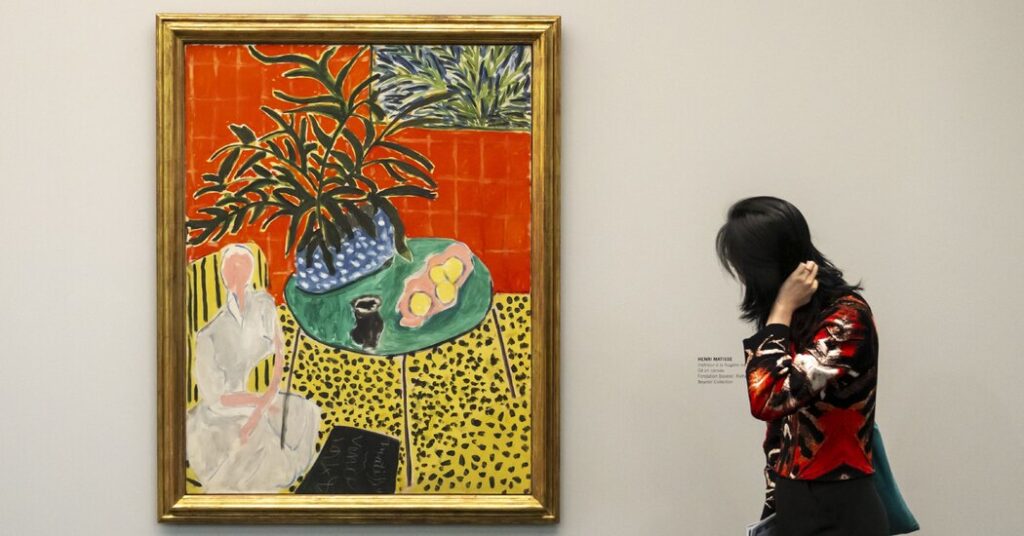Sales in the international art market declined 12 percent in 2024, according to the Art Basel and UBS Global Art Market Report published on Tuesday. The annual report, seen as the most reliable indicator of the art market’s size and health, said that sales had fallen for the second year in a row.
“Decline in value was driven by cooling at the top end,” says the report, which describes 2024 as “a year of continuing geopolitical tensions, economic volatility and trade fragmentation.” Auction sales of single works that fetched more than $10 million fell by 39 percent, the report says, and galleries with a turnover of more than $10 million saw sales fall 9 percent.
“People were more risk-averse,” said Clare McAndrew, the economist who wrote the report, in an interview. “On the supply side, people were waiting to see how things panned out and held on. That impacted what came on to the market.”
“Buyers were looking at this uncertain, volatile picture, and wanted to put money into something that was more liquid, or something that gave them income,” McAndrew said.
The report — which is the most widely cited survey of activity in the notoriously opaque international art market — estimates the total value of global art sales in 2024 at $57.5 billion, based on publicly available data from auction houses and survey responses from some 1,600 dealers.
Sales reached a peak of $68.2 billion in 2014, according to the report, but have been flat or falling since then, even though billionaire wealth has more than doubled in the last 10 years, reaching a record $15.6 trillion. In that time, sales of other luxury goods have soared; LVMH, the world’s biggest luxury conglomerate, posted annual turnover of about $88 billion last year.
“There’s so much wealth in different parts of the world that isn’t buying art at the moment,” McAndrew said.
“The focus is so much on the core people who are already buying,” she added. “The growth has to come with expanding the realm of interest.”
Last year, sales declined in all of the art trade’s key geographic regions, the report says. The United States retained its position as the dominant marketplace, but turnover fell 9 percent to $24.8 billion, owing in part, the report says, to “the political uncertainty surrounding the presidential election.” Despite “Brexit-related challenges,” Britain regained second place with $10.4 billion of sales, contracting just 5 percent year-on-year, according to the report. Art sales fell a hefty 31 percent in China to $8.4 billion, its lowest level since 2009, as a result of “slower economic growth, a continued property market slump and other economic challenges,” the report says.
The one bright spot in the report was an increase in activity at lower price levels.
The global art trade’s overall number of transactions grew 3 percent in 2024 to 40.5 million, a peak, driven by the post-pandemic expansion of online trading, the report says. Auction sales of works sold for below $5,000, the report adds, an increase of 7 percent, while smaller dealers with turnover of less than $250,000 reported a 17 percent rise in business, their second consecutive year of growth. The smallest dealers attracted the biggest share of new buyers, “highlighting the importance of smaller galleries in expanding the market to a wider audience,” according to Art Basel and UBS.
Looking forward, the report said 80 percent of dealers expected stable or improved sales. However, those upbeat responses had been compiled before President Trump’s announcement last Wednesday of steep tariffs on nearly all imports to the United States and the stock market falls that followed. Although, for the moment, art appears to be mostly exempt from U.S. tariffs, dealers are fretting about how these measures, and the economic turmoil they are causing, will damage the international art trade.
“It’s bad,” said McAndrew, who emphasized that the effects of tariffs remained unclear. “The growth of the contemporary market has been built around goods being able to move easily across borders. It’s the worst possible time for the art market to be hit.”
“There will still be the potential of reciprocal ones, and the damage they might do, more generally, will still filter down,” she added.
The “geopolitical tensions, economic volatility and trade fragmentation” that the UBS and Art Basel report identified as suppressants in 2024 don’t look set to ease any time soon.
https://www.nytimes.com/2025/04/08/arts/design/art-basel-ubs-art-market-report.html


